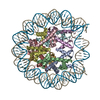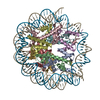+ Open data
Open data
- Basic information
Basic information
| Entry | Database: PDB / ID: 9fgq | |||||||||
|---|---|---|---|---|---|---|---|---|---|---|
| Title | Structure of human APC3loop 375-381 bound to the NCP | |||||||||
 Components Components |
| |||||||||
 Keywords Keywords | CELL CYCLE / Arginine anchor / NCP / APC3 / Complex | |||||||||
| Function / homology |  Function and homology information Function and homology informationConversion from APC/C:Cdc20 to APC/C:Cdh1 in late anaphase / Inactivation of APC/C via direct inhibition of the APC/C complex / APC/C:Cdc20 mediated degradation of mitotic proteins / anaphase-promoting complex / Aberrant regulation of mitotic exit in cancer due to RB1 defects / regulation of meiotic cell cycle / metaphase/anaphase transition of mitotic cell cycle / anaphase-promoting complex-dependent catabolic process / Phosphorylation of the APC/C / protein K11-linked ubiquitination ...Conversion from APC/C:Cdc20 to APC/C:Cdh1 in late anaphase / Inactivation of APC/C via direct inhibition of the APC/C complex / APC/C:Cdc20 mediated degradation of mitotic proteins / anaphase-promoting complex / Aberrant regulation of mitotic exit in cancer due to RB1 defects / regulation of meiotic cell cycle / metaphase/anaphase transition of mitotic cell cycle / anaphase-promoting complex-dependent catabolic process / Phosphorylation of the APC/C / protein K11-linked ubiquitination / Regulation of APC/C activators between G1/S and early anaphase / Transcriptional Regulation by VENTX / negative regulation of megakaryocyte differentiation / protein localization to CENP-A containing chromatin / Chromatin modifying enzymes / Replacement of protamines by nucleosomes in the male pronucleus / CENP-A containing nucleosome / heterochromatin organization / epigenetic regulation of gene expression / Packaging Of Telomere Ends / Recognition and association of DNA glycosylase with site containing an affected purine / Cleavage of the damaged purine / Deposition of new CENPA-containing nucleosomes at the centromere / nucleosomal DNA binding / Recognition and association of DNA glycosylase with site containing an affected pyrimidine / Cleavage of the damaged pyrimidine / regulation of mitotic cell cycle / Inhibition of DNA recombination at telomere / APC/C:Cdc20 mediated degradation of Cyclin B / Meiotic synapsis / APC-Cdc20 mediated degradation of Nek2A / telomere organization / RNA Polymerase I Promoter Opening / Interleukin-7 signaling / Assembly of the ORC complex at the origin of replication / SUMOylation of chromatin organization proteins / DNA methylation / Condensation of Prophase Chromosomes / ERCC6 (CSB) and EHMT2 (G9a) positively regulate rRNA expression / SIRT1 negatively regulates rRNA expression / Chromatin modifications during the maternal to zygotic transition (MZT) / HCMV Late Events / PRC2 methylates histones and DNA / Autodegradation of Cdh1 by Cdh1:APC/C / APC/C:Cdc20 mediated degradation of Securin / Defective pyroptosis / Assembly of the pre-replicative complex / HDACs deacetylate histones / Cdc20:Phospho-APC/C mediated degradation of Cyclin A / RNA Polymerase I Promoter Escape / Nonhomologous End-Joining (NHEJ) / Transcriptional regulation by small RNAs / Formation of the beta-catenin:TCF transactivating complex / APC/C:Cdh1 mediated degradation of Cdc20 and other APC/C:Cdh1 targeted proteins in late mitosis/early G1 / RUNX1 regulates genes involved in megakaryocyte differentiation and platelet function / NoRC negatively regulates rRNA expression / Activated PKN1 stimulates transcription of AR (androgen receptor) regulated genes KLK2 and KLK3 / B-WICH complex positively regulates rRNA expression / G2/M DNA damage checkpoint / HDMs demethylate histones / DNA Damage/Telomere Stress Induced Senescence / Metalloprotease DUBs / CDK-mediated phosphorylation and removal of Cdc6 / mitotic spindle / PKMTs methylate histone lysines / Meiotic recombination / RMTs methylate histone arginines / Pre-NOTCH Transcription and Translation / Activation of anterior HOX genes in hindbrain development during early embryogenesis / HCMV Early Events / spindle / Transcriptional regulation of granulopoiesis / structural constituent of chromatin / Separation of Sister Chromatids / UCH proteinases / nucleosome / nucleosome assembly / Antigen processing: Ubiquitination & Proteasome degradation / E3 ubiquitin ligases ubiquitinate target proteins / Recruitment and ATM-mediated phosphorylation of repair and signaling proteins at DNA double strand breaks / chromatin organization / RUNX1 regulates transcription of genes involved in differentiation of HSCs / Factors involved in megakaryocyte development and platelet production / gene expression / HATs acetylate histones / Processing of DNA double-strand break ends / Senescence-Associated Secretory Phenotype (SASP) / protein phosphatase binding / Oxidative Stress Induced Senescence / Estrogen-dependent gene expression / chromosome, telomeric region / Ub-specific processing proteases / protein ubiquitination / cadherin binding / protein heterodimerization activity / Amyloid fiber formation / cell division / centrosome / protein-containing complex / DNA binding Similarity search - Function | |||||||||
| Biological species |  Homo sapiens (human) Homo sapiens (human) | |||||||||
| Method | ELECTRON MICROSCOPY / single particle reconstruction / cryo EM / Resolution: 2.5 Å | |||||||||
 Authors Authors | Young, R.V.C. / Muhammad, R. / Alfieri, C. | |||||||||
| Funding support |  United Kingdom, 2items United Kingdom, 2items
| |||||||||
 Citation Citation |  Journal: To be published Journal: To be publishedTitle: Spatial control of the APC/C ensures the rapid degradation of Cyclin B1 Authors: Cirillo, L. / Young, R.V.C. / Veerapathiran, S. / Roberti, A. / Martin, M. / Abubacar, A. / Perosa, C. / Coates, C. / Muhammad, R. / Roumeliotis, T.I. / Choudhary, J.S. / Alfieri, C. / Pines, J. | |||||||||
| History |
|
- Structure visualization
Structure visualization
| Structure viewer | Molecule:  Molmil Molmil Jmol/JSmol Jmol/JSmol |
|---|
- Downloads & links
Downloads & links
- Download
Download
| PDBx/mmCIF format |  9fgq.cif.gz 9fgq.cif.gz | 395.3 KB | Display |  PDBx/mmCIF format PDBx/mmCIF format |
|---|---|---|---|---|
| PDB format |  pdb9fgq.ent.gz pdb9fgq.ent.gz | 235.8 KB | Display |  PDB format PDB format |
| PDBx/mmJSON format |  9fgq.json.gz 9fgq.json.gz | Tree view |  PDBx/mmJSON format PDBx/mmJSON format | |
| Others |  Other downloads Other downloads |
-Validation report
| Summary document |  9fgq_validation.pdf.gz 9fgq_validation.pdf.gz | 1.1 MB | Display |  wwPDB validaton report wwPDB validaton report |
|---|---|---|---|---|
| Full document |  9fgq_full_validation.pdf.gz 9fgq_full_validation.pdf.gz | 1.1 MB | Display | |
| Data in XML |  9fgq_validation.xml.gz 9fgq_validation.xml.gz | 32.5 KB | Display | |
| Data in CIF |  9fgq_validation.cif.gz 9fgq_validation.cif.gz | 51 KB | Display | |
| Arichive directory |  https://data.pdbj.org/pub/pdb/validation_reports/fg/9fgq https://data.pdbj.org/pub/pdb/validation_reports/fg/9fgq ftp://data.pdbj.org/pub/pdb/validation_reports/fg/9fgq ftp://data.pdbj.org/pub/pdb/validation_reports/fg/9fgq | HTTPS FTP |
-Related structure data
| Related structure data |  50416MC  9fh9C M: map data used to model this data C: citing same article ( |
|---|---|
| Similar structure data | Similarity search - Function & homology  F&H Search F&H Search |
- Links
Links
- Assembly
Assembly
| Deposited unit | 
|
|---|---|
| 1 |
|
- Components
Components
-Protein , 5 types, 10 molecules KLAEBFCGDH
| #1: Protein | Mass: 32788.488 Da / Num. of mol.: 2 Source method: isolated from a genetically manipulated source Details: This is a disorder loop of human APC3 residues 177-446 fused to a SpyTag via a 27 residue GSA linker. Source: (gene. exp.)  Homo sapiens (human) / Gene: CDC27, ANAPC3, D0S1430E, D17S978E / Plasmid: pFastBac1 / Production host: Homo sapiens (human) / Gene: CDC27, ANAPC3, D0S1430E, D17S978E / Plasmid: pFastBac1 / Production host:  Trichoplusia ni (cabbage looper) / References: UniProt: P30260 Trichoplusia ni (cabbage looper) / References: UniProt: P30260#2: Protein | Mass: 15437.167 Da / Num. of mol.: 2 Source method: isolated from a genetically manipulated source Details: Human histone H3.1 / Source: (gene. exp.)  Homo sapiens (human) Homo sapiens (human)Gene: HIST1H3A, H3FA, HIST1H3B, H3FL, HIST1H3C, H3FC, HIST1H3D, H3FB, HIST1H3E, H3FD, HIST1H3F, H3FI, HIST1H3G, H3FH, HIST1H3H, H3FK, HIST1H3I, H3FF, HIST1H3J, H3FJ Production host:  #3: Protein | Mass: 11394.426 Da / Num. of mol.: 2 Source method: isolated from a genetically manipulated source Details: Human histone H4 / Source: (gene. exp.)  Homo sapiens (human) Homo sapiens (human)Gene: HIST1H4A, H4/A, H4FA, HIST1H4B, H4/I, H4FI, HIST1H4C, H4/G, H4FG, HIST1H4D, H4/B, H4FB, HIST1H4E, H4/J, H4FJ, HIST1H4F, H4/C, H4FC, HIST1H4H, H4/H, H4FH, HIST1H4I, H4/M, H4FM, HIST1H4J, H4/E, ...Gene: HIST1H4A, H4/A, H4FA, HIST1H4B, H4/I, H4FI, HIST1H4C, H4/G, H4FG, HIST1H4D, H4/B, H4FB, HIST1H4E, H4/J, H4FJ, HIST1H4F, H4/C, H4FC, HIST1H4H, H4/H, H4FH, HIST1H4I, H4/M, H4FM, HIST1H4J, H4/E, H4FE, HIST1H4K, H4/D, H4FD, HIST1H4L, H4/K, H4FK, HIST2H4A, H4/N, H4F2, H4FN, HIST2H4, HIST2H4B, H4/O, H4FO, HIST4H4 Production host:  #4: Protein | Mass: 14125.549 Da / Num. of mol.: 2 Source method: isolated from a genetically manipulated source Details: This is a H2A/H2B fusion protein with a SpyCatcher tag attached Source: (gene. exp.)  Homo sapiens (human) Homo sapiens (human)Gene: H2AC18, H2AFO, HIST2H2AA, HIST2H2AA3, H2AC19, HIST2H2AA4 Plasmid: pET-14b / Production host:  #5: Protein | Mass: 29445.771 Da / Num. of mol.: 2 Source method: isolated from a genetically manipulated source Details: This is a H2A/H2B fusion protein with a SpyCatcher tag attached,This is a H2A/H2B fusion protein with a SpyCatcher tag attached Source: (gene. exp.)  Homo sapiens (human) / Gene: H2BC3, H2BFF, HIST1H2BB / Plasmid: pET-14b / Production host: Homo sapiens (human) / Gene: H2BC3, H2BFF, HIST1H2BB / Plasmid: pET-14b / Production host:  |
|---|
-DNA chain , 2 types, 2 molecules IJ
| #6: DNA chain | Mass: 64911.336 Da / Num. of mol.: 1 Source method: isolated from a genetically manipulated source Details: The Widom 147 bp sequence with 32 nucleotides of DNA on either side Source: (gene. exp.)  Homo sapiens (human) / Production host: Homo sapiens (human) / Production host:  |
|---|---|
| #7: DNA chain | Mass: 65382.633 Da / Num. of mol.: 1 Source method: isolated from a genetically manipulated source Details: Widom 147 DNA sequence flanked with 32 nucleotides on either side Source: (gene. exp.)  Homo sapiens (human) / Production host: Homo sapiens (human) / Production host:  |
-Non-polymers , 1 types, 75 molecules 
| #8: Water | ChemComp-HOH / |
|---|
-Experimental details
-Experiment
| Experiment | Method: ELECTRON MICROSCOPY |
|---|---|
| EM experiment | Aggregation state: PARTICLE / 3D reconstruction method: single particle reconstruction |
- Sample preparation
Sample preparation
| Component | Name: APC3 motif bound to the NCP acidic patch / Type: COMPLEX Details: Recombinant protein sample of residues 375-381 of APC3 Entity ID: #1-#3, #6-#7 / Source: RECOMBINANT | ||||||||||||||||||||
|---|---|---|---|---|---|---|---|---|---|---|---|---|---|---|---|---|---|---|---|---|---|
| Molecular weight |
| ||||||||||||||||||||
| Source (natural) | Organism:  Homo sapiens (human) Homo sapiens (human) | ||||||||||||||||||||
| Source (recombinant) | Organism:  | ||||||||||||||||||||
| Buffer solution | pH: 8 / Details: 20 mM HEPEs pH8.0, 50 mM NaCl, 0.5 mM TCEP | ||||||||||||||||||||
| Buffer component |
| ||||||||||||||||||||
| Specimen | Embedding applied: NO / Shadowing applied: NO / Staining applied: NO / Vitrification applied: YES | ||||||||||||||||||||
| Specimen support | Grid material: COPPER / Grid mesh size: 300 divisions/in. / Grid type: Quantifoil R1.2/1.3 | ||||||||||||||||||||
| Vitrification | Instrument: FEI VITROBOT MARK III / Cryogen name: ETHANE / Humidity: 100 % / Chamber temperature: 277 K |
- Electron microscopy imaging
Electron microscopy imaging
| Experimental equipment |  Model: Titan Krios / Image courtesy: FEI Company |
|---|---|
| Microscopy | Model: TFS KRIOS |
| Electron gun | Electron source:  FIELD EMISSION GUN / Accelerating voltage: 300 kV / Illumination mode: FLOOD BEAM FIELD EMISSION GUN / Accelerating voltage: 300 kV / Illumination mode: FLOOD BEAM |
| Electron lens | Mode: BRIGHT FIELD / Nominal defocus max: 1600 nm / Nominal defocus min: 600 nm / Cs: 2.7 mm |
| Image recording | Electron dose: 62 e/Å2 / Film or detector model: GATAN K3 (6k x 4k) |
- Processing
Processing
| EM software |
| ||||||||||||||||||||||||
|---|---|---|---|---|---|---|---|---|---|---|---|---|---|---|---|---|---|---|---|---|---|---|---|---|---|
| CTF correction | Type: PHASE FLIPPING AND AMPLITUDE CORRECTION | ||||||||||||||||||||||||
| Particle selection | Num. of particles selected: 2698450 Details: Template base particel picking and Topaz trained particle picking | ||||||||||||||||||||||||
| 3D reconstruction | Resolution: 2.5 Å / Resolution method: FSC 0.143 CUT-OFF / Num. of particles: 414277 / Symmetry type: POINT | ||||||||||||||||||||||||
| Refinement | Cross valid method: NONE Stereochemistry target values: GeoStd + Monomer Library + CDL v1.2 | ||||||||||||||||||||||||
| Displacement parameters | Biso mean: 50.81 Å2 | ||||||||||||||||||||||||
| Refine LS restraints |
|
 Movie
Movie Controller
Controller




 PDBj
PDBj

















































